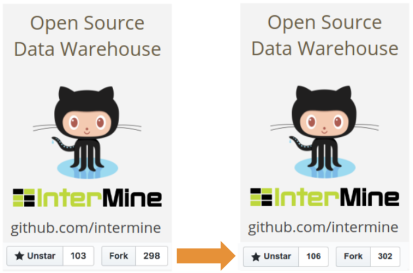We are excited to publish the latest version of InterMine, version 4.0.
It’s a collection of our efforts to make InterMine more “FAIR“. As an open source data warehouse, InterMine’s raison d’être is to be a framework that enables people to quickly and easily provide public access to their data in a user friendly manner. Therefore InterMine has always strived to make data Findable, Accessible, Interoperable and Reusable and this push is meant to formally apply the FAIR principles to InterMine.
What’s included in this release?
- Generate globally unique and stable URLs to identify InterMine data objects in order to provide more findable and accessible data.
- Apply suitable ontologies to the core InterMine data model to make the semantic of InterMine data explicit and facilitate data exchange and interoperability
- Embed metadata in InterMine web pages to make data more findable
- Improve accessibility of data licenses for integrated sources via web interface and REST web-service.
More details below!
How to upgrade?
This is a non-disruptive release, but there are additions to the data model. Therefore, you’ll want to increment your version, then build a new database when upgrading. No other action is required.
However, keep reading for how to take advantages of the new FAIR features in this release.
Unique and stable URLs
We’ve added a beautiful new user-friendly URL.
Example: http://beta.flymine.org/beta/gene:FBgn0000606
Currently this is used only in the “share” button in the report pages and in the web pages markup. In the future, this will be the only URL seen in the browser location bar.
For details on how to configure your mine’s URLs, see the docs here.
See our previous blog posts on unique identifiers.
Decorating the InterMine data model with ontology terms
InterMine 4.0 introduces the ability to annotate your InterMine data model with ontology terms.
While these data are not used (yet), it’s an important feature in that it’s going to facilitate cross-InterMine querying, and eventually cross-database analysis — allowing us to answer questions like “Is the ‘gene’ in MouseMine the same ‘gene’ at the EBI?”.
For details on how to add ontologies to your InterMine data model, see the docs here.
Embedding metadata in InterMine webpages
We’ve added structured data to web pages in format of JSON-LD to make data more findable, and these data are indexed by Google data search. Bioschemas.org is extending Schema.org with life science-specific types, adding required properties and cardinality on the types. For more details see the docs here.
By default this feature is disabled. For details on how to enable embedding metadata in your webpages, see the docs here.
Data licences
In our ongoing effort to make the InterMine system more FAIR, we have started working on improving the accessibility of data licences, retaining licence information supplied by the data sources integrated in InterMine, and making it available to humans via our web application and machines via queries.
See our previous blog post on data licences.
For details on how to add data licences to your InterMine, see the docs.
Future FAIR plans
- Provide a RDF representation of data stored, lists and query results, and the bulk download of all InterMine in RDF form, in order to allow the users to import InterMine resources into their local triplestore
- Provide an infrastructure for a SPARQL endpoint where the user can perform federated queries over multiple data sets
Upcoming Releases
The next InterMine version will likely be ready in the Fall/Winter and include some user interface updates.
Docs
To update your mine with these new changes, see upgrade instructions. This is a non-disruptive release.
See release notes for detailed information.
















You must be logged in to post a comment.